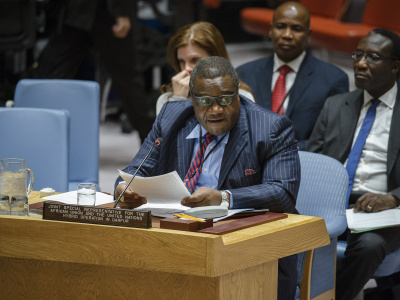
How the EU can step up its support to conflict prevention and peacebuilding
Conflict prevention and peacebuilding (CPPB) is more needed than ever, given the rising number of violent conflicts in the world. While most of these conflicts take place at sub-national levels, many also spill over across national borders. Since the early 2000s, the European Union (EU) has supported CPPB efforts – and particularly in the past ten years. But has the EU been successful in promoting CPPB globally? Has it contributed to making the world a safer place? And has the EU improved its way of operating and supporting CPPB since its last evaluation ten years ago?
These are some of the key questions that the new external evaluation of the EU’s support for conflict prevention and peacebuilding between 2013 and 2018 provides answers to.
The evaluation was carried out by Particip and ECDPM, commissioned by the European Commission’s Directorate-General for International Cooperation and Development (DG DEVCO) and accompanied by the neighbourhood and humanitarian assistance directorates-general (DG NEAR and DG ECHO), FPI (Service for Foreign Policy Instruments) and the European External Action Service (EEAS).
It lasted 18 months and was based on a review of some 500 documents, a survey conducted among EU delegations, over 600 interviews, and 12 case studies that zoomed in on countries in Africa, Latin America, South-East Asia and the European Neighbourhood. At the end of November, we presented the results during a virtual seminar organised by the European Commission.
Given the European Commission’s ambition to make the EU a more important global player and the ongoing thematic and country programming of the new seven-year EU budget, this evaluation couldn’t have come at a better time. Conflict prevention and peacebuilding, which received EUR 5.6bn between 2013 and 2018, has become a cornerstone of the EU’s external action. It is an area of engagement where the EU can translate its foundational elements and values – in essence a peace project – into global action for a better and safer world.
But has the EU managed to achieve its ambitions so far? How relevant, effective and coherent was its CPPB support considering the plethora of institutional arrangements, instruments, funding and non-spending activities? Does the EU add value to what member states and other international actors are doing in this field? And, most importantly, what results has the EU’s support achieved in the short, medium and long term?
The EU has progressed on a number of fronts…
Since 2011, the EU overall did well and improved its way of working when providing CPPB support. The EU strengthened its policy frameworks, streamlined some of its institutional structures, sought to strengthen human resources, and promoted cooperation and coordination between its institutions. And as such, the quality of the EU’s coherence in supporting CPPB increased.
Case studies, for instance the one on Colombia, reveal that the EU’s coherence and complementarity of engagement were strengthened if explicit CPPB strategies and political frameworks were in place. In those instances, the engagement was led by clear guidance on how to take the policies forward and an integrated approach was promoted through well-coordinated financing and non-spending activities such as diplomatic interventions or policy dialogue.
The EU’s CPPB support was relatively successful in achieving short- to medium-term results, as the cases of Colombia, Côte d’Ivoire, Georgia, the Philippines and Zimbabwe show. But the EU had limited success in terms of longer-term impact on preventing and mitigating violence, restoring immediate stability, and creating more structural stability.
Nevertheless, in several places, we saw the consequences and effects of the EU’s support – think of signed peace agreements, the prevention of local level conflicts or the restoration of state security functions. Other results were less tangible, such as the jump-starting of mediation processes or confidence building between conflicting parties, as was the case in Georgia.
…but there is also room for improvement
The evaluation report shares many relevant findings and recommendations for how to advance the EU’s support to conflict prevention and peacebuilding – but two key takeaways stand out.
First, twenty years after the 2001 Gothenburg Programme and the EU’s last dedicated policy statement on conflict prevention and peacebuilding, the EU has not updated its policy messaging on what constitutes CPPB. It also does not offer any guidance on how to approach its support to CPPB and how this fits into a rapidly changing world. As a consequence, the EU has not integrated explicit policy and strategic objectives systematically across its CPPB engagement, which has diminished the value of its activities.
We therefore recommended the EU to publish an updated EU communication that clarifies the EU’s political objectives in engaging in CPPB, provides a clear conceptual framework defining CPPB, and explains how the high-level CPPB political priorities and objectives can be translated into strategy documents and project implementation documents. This would help to improve the effectiveness of the EU’s CPPB support.
Second, the evaluation has shown that the EU is a unique and important actor in conflict prevention and peacebuilding. But its added value can be further enhanced by ensuring that all resources are deployed in an integrated manner. This starts, but does not end with the deployment of conflict-sensitive approaches. Conflict-sensitivity and more conflict analyses are indispensable for the effectiveness of all EU support proposed under the new Neighbourhood, Development and International Cooperation Instrument (NDICI) – and not just those specifically focused on peace and stability and rapid reaction.
This needs to extend to all domains of the EU’s external action, including migration management, trade relationships and investment decisions. At the same time, conflict and risk analyses are only one aspect of developing a conflict-sensitive approach to CPPB. Integrating the results of such analyses systematically into the organisational routine is equally essential.
This requires sufficient as well as appropriately selected and trained human resources. The evaluation highlighted this as an area for further improvement, in particular at the EU delegation level. There, the interaction between the political and the operational staff is vital to ensure that policies translate into effective programming, implementation and monitoring.
The EU’s investments in conflict prevention and peacebuilding over the past ten years have been promising. What is needed now is a next level of engagement to put CPPB even more prominently on the agenda.
The views are those of the author and not necessarily those of ECDPM. The author is grateful to Nicole Ball, team leader of the external evaluation, for providing comments.




